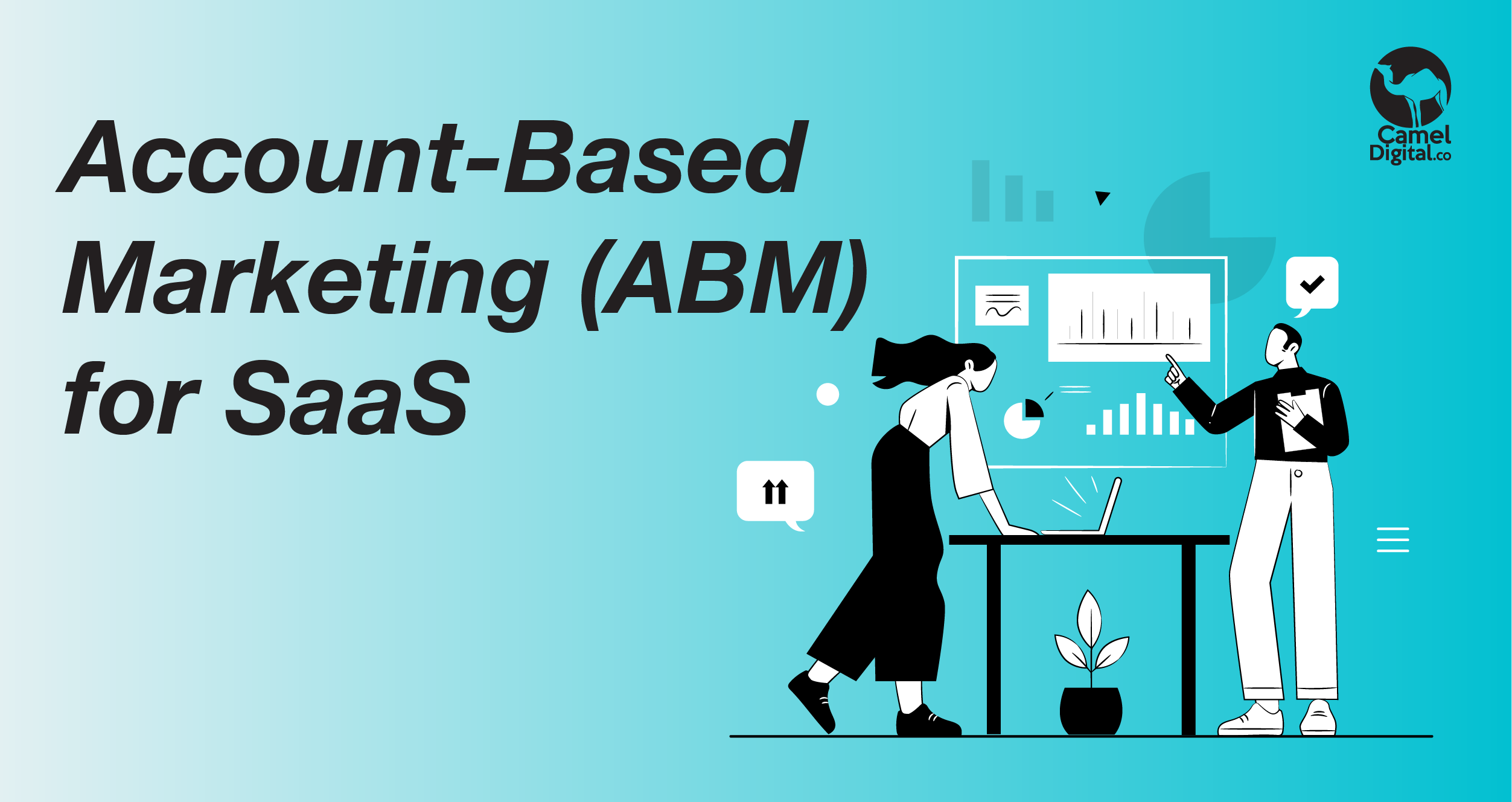In B2B SaaS marketing, choosing the right target isn’t enough. Choosing the precisely right one is.
You can define your ICP, build segments, and run ads to broad categories like “IT managers at mid-sized companies.” But if you want to hit exactly the right companies, with the right message, at the right moment, you need a good SaaS ABM strategy.
By aligning sales and marketing around high-value accounts, this approach delivers measurable results: companies using ABM see a 74% revenue increase, with target accounts moving through the pipeline 234% faster.
That’s why global players like GumGum and Auth0 rely on ABM SaaS strategies—and why your business should too.
What is ABM for SaaS?
Account-Based Marketing (ABM) for SaaS is a focused strategy where marketing and sales work together to target a specific list of high-value companies.
Instead of attracting a wide range of leads like traditional inbound marketing, SaaS ABM strategy goes directly to the companies and their key decision-makers with personalized ads, cold emails, and content.
In B2B SaaS, ABM is especially effective. Sales cycles are long, deals involve several stakeholders, and generic marketing often gets ignored.
B2B SaaS ABM ensures your message reaches the right people inside the right companies, making your outreach more relevant, your pipeline stronger, and your deals more likely to close.
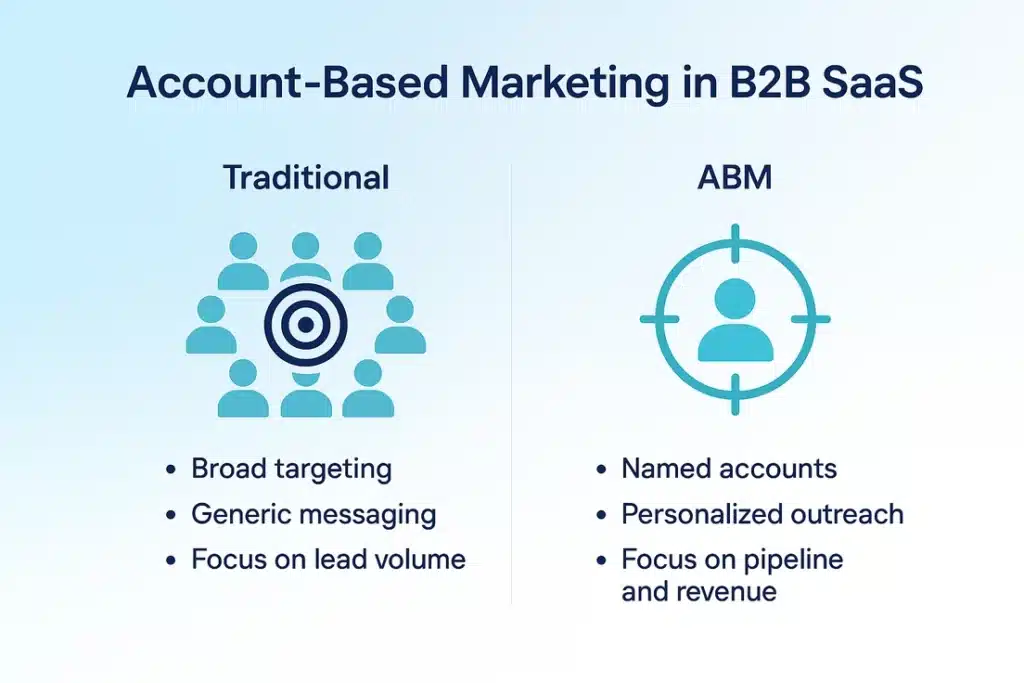
Why SaaS Companies Are Turning to ABM
Ask this question to an average SaaS marketer who’s spent months explaining to the CEO why the pipeline is thin and the ad spend isn’t converting.
First and foremost, ABM for SaaS shortens sales cycles.
Instead of chasing random leads and hoping they fit, ABM lets marketers go straight to the right accounts – the ones that actually close. Reaching decision-makers directly cuts sales cycles by up to 50%, prioritizing focus over volume, and speed over guesswork.
Further, with SaaS ABM, you spend your SaaS marketing budget more effectively.
Targeted spend drives better results. Companies that track ABM ROI report 45% somewhat higher and 36% significantly higher returns compared to traditional marketing. ABM limits budget waste because ads are shown only to predefined accounts, reducing irrelevant clicks.
SaaS ABM aligns sales and Marketing around the same targets.
According to UserGems, 82% of marketers say ABM improves alignment between sales and marketing. While Marketing starts by engaging predefined accounts with tailored ads, content, or email, sales builds on that by targeting those same accounts with direct outreach. This shared focus reduces misalignment and improves lead quality.
ABM Boosts SaaS ROI, ROAS, and customer retention.
87% of marketers claim that account-based marketing delivers higher ROI than any other type of marketing strategy. Similarly, companies using ABM report higher ROAS, as budgets are spent only on high-fit accounts that are more likely to convert. With fewer wasted impressions and more relevant engagement, cost per acquisition drops while deal value increases.
How SaaS ABM Works: Strategy Breakdown
ABM only works when each step follows a clear and logical order. You start by selecting the right accounts, then find out exactly who is involved in the buying process. If you skip those steps or get them wrong, your personalized campaigns won’t reach the right people. Every decision builds on the previous one, so accuracy early on directly affects pipeline results later.
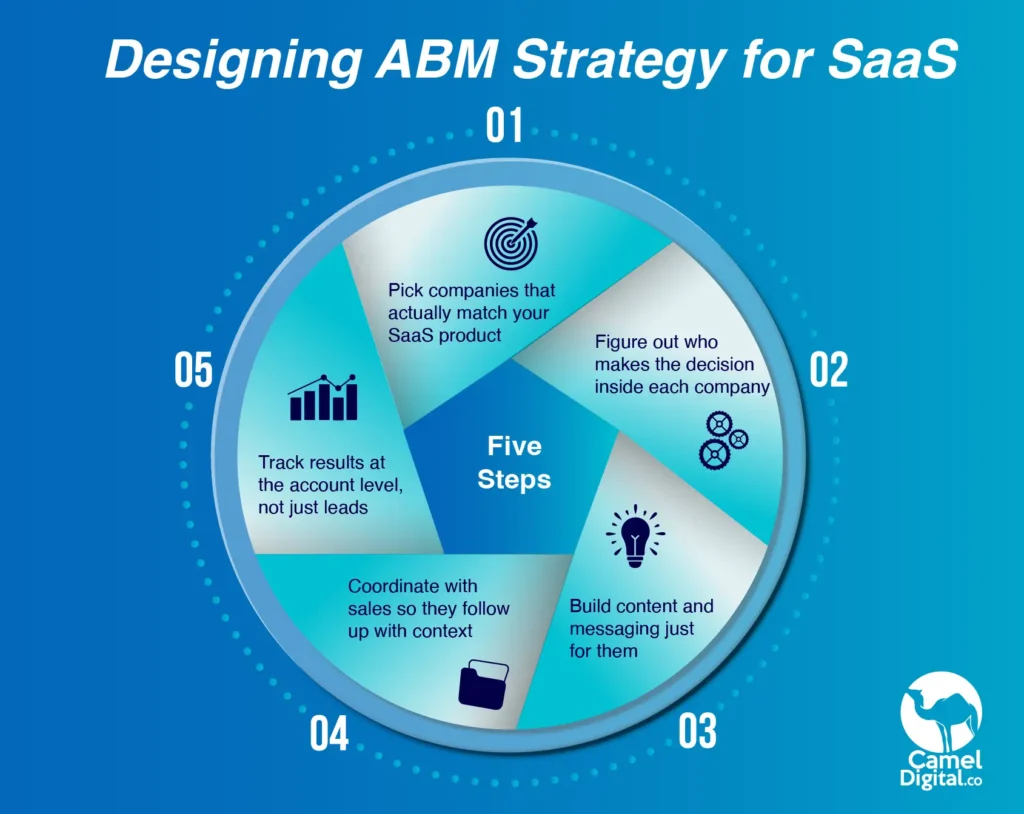
1. Identify and Prioritize High-Value Accounts
Every effective B2B SaaS ABM strategy starts by knowing exactly which companies you want to reach. Instead of casting a wide net, ABM requires a focused list of accounts that are a strong fit for your product and have clear potential for long-term value. That’s why defining your Ideal Customer Profile (ICP) is the first step.
Your ICP outlines the firm-level attributes (not individual contacts) that make a company an ideal fit based on business model, product fit, and revenue opportunity.
A good ICP includes Filters and Signals.
- Filters are non-negotiable: things like industry, company size, tech stack, or geographic focus.
- Signals are helpful but optional, such as growth rate, market share, or whether they use a competitor’s product.
Together, these give you a structured way to assess fit beyond surface-level data.
To build your ICP, start by analyzing your best existing customers. Look at those with high retention, strong usage, and low churn. Gather insights from sales and customer success, and use CRM data to spot patterns. Once your ICP is clear, narrow down your Serviceable Addressable Market (SAM) to a prioritized list of high-fit accounts.
Example: If you’re a SaaS platform built for finance teams in tech companies, a filter might be “US-based tech companies with 200-1,000 employees,” and a signal could be “currently hiring senior finance roles” or “using legacy FP&A software.”
Once you’ve built the list, layer in intent data to see which accounts are actively researching solutions like yours, then segment into tiers based on fit and readiness.
2. Map the Buying Committee
In B2B SaaS, you rarely sell to just one person, even if you’re speaking only with one contact. Most deals are decided by a buying committee that can range from 6 to 15 people.
These individuals bring different perspectives, priorities, and influence to the table, so you should prepare your sales offer with each member’s needs in mind because they will evaluate and discuss it together before making a decision.
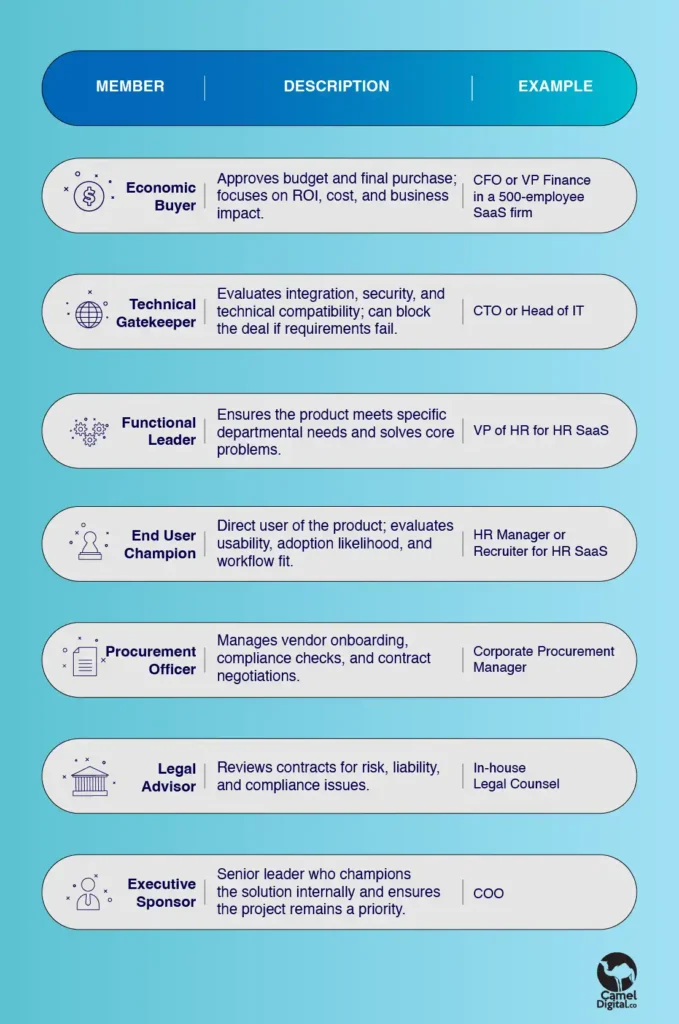
Start with the contact you already know and work outward. Ask direct but neutral questions like, “Who else will be involved in evaluating this solution?” or “Which departments will need to review this?”
This often reveals both decision-makers and less visible influencers.
Use LinkedIn Sales Navigator, company websites, and tools like ZoomInfo to fill in the missing names. Once you have them, log each role in your CRM so both marketing and sales know exactly who to target.
3. Create Hyper-Personalized Campaigns
Start by deciding the order of engagement. In many SaaS deals, it works best to build awareness with influencers inside the account before moving up to final decision-makers.
For example, you might first run LinkedIn Sponsored Content targeted to department heads and end users who will benefit most from your product. These early touches build internal interest and generate engagement signals.
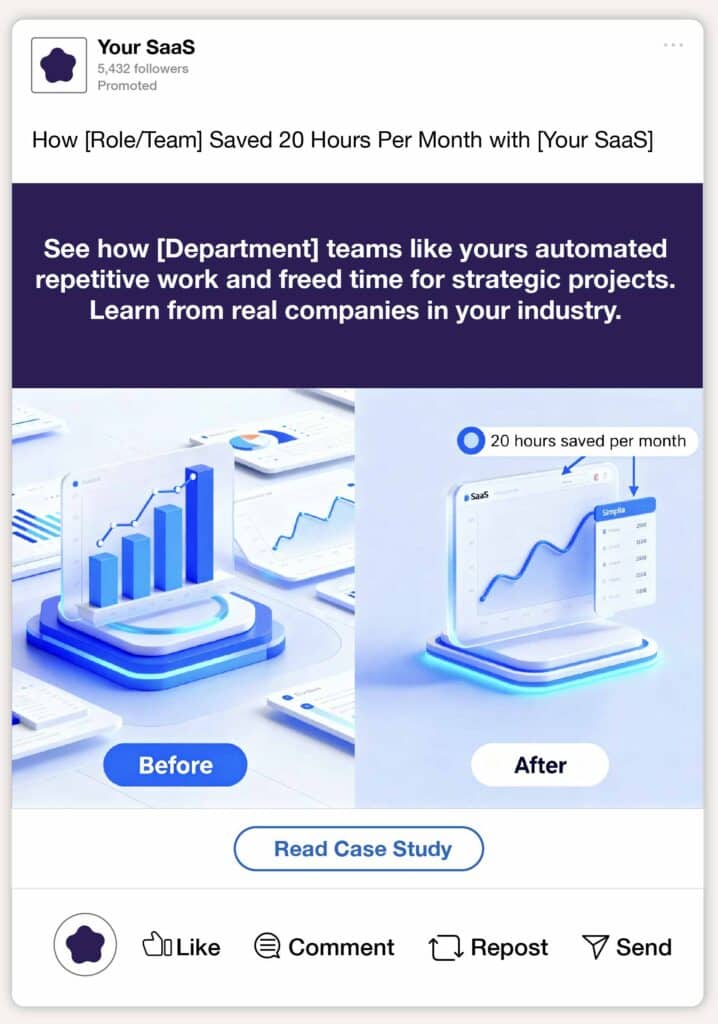
Once you have engagement, introduce deeper technical proof for roles that control implementation. Send webinar invites or gated technical documentation directly to IT and operations contacts.
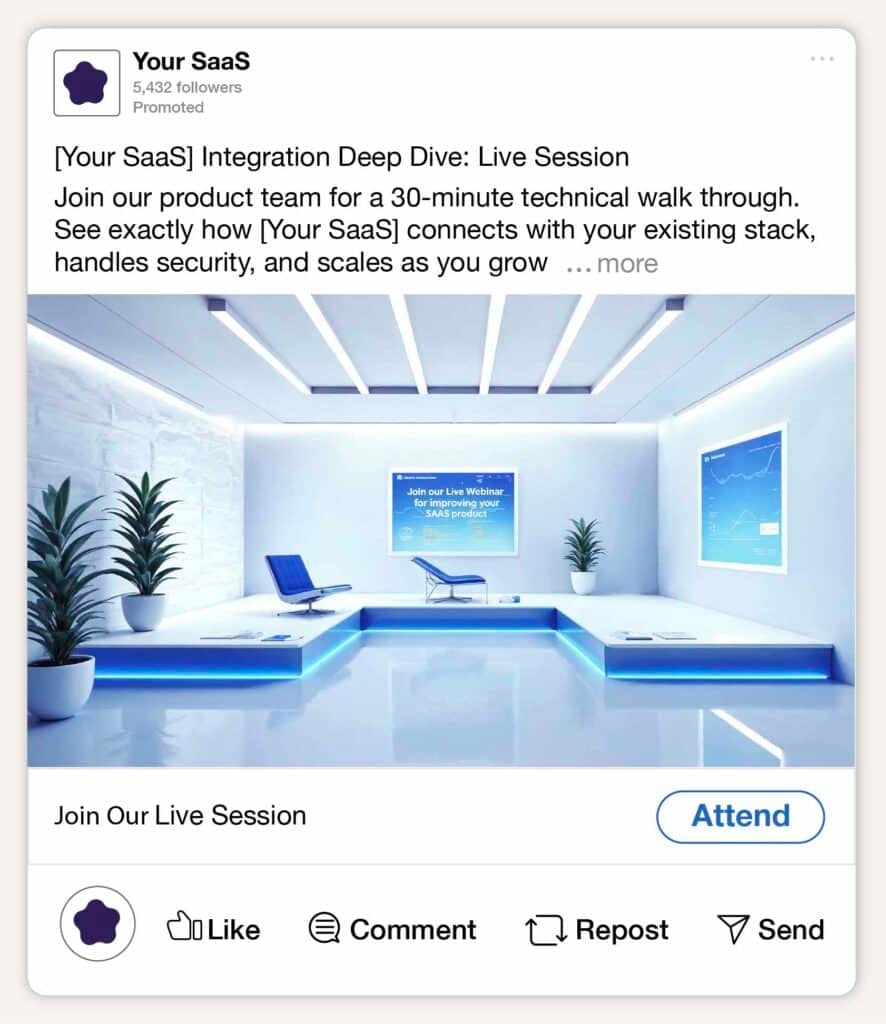
Finally, move to the economic buyer with a focused value argument. This could be a personalized ROI calculator sent via email along with a one-page case study that mirrors their company size and industry. At this stage, you want concise, measurable outcomes, not product details.
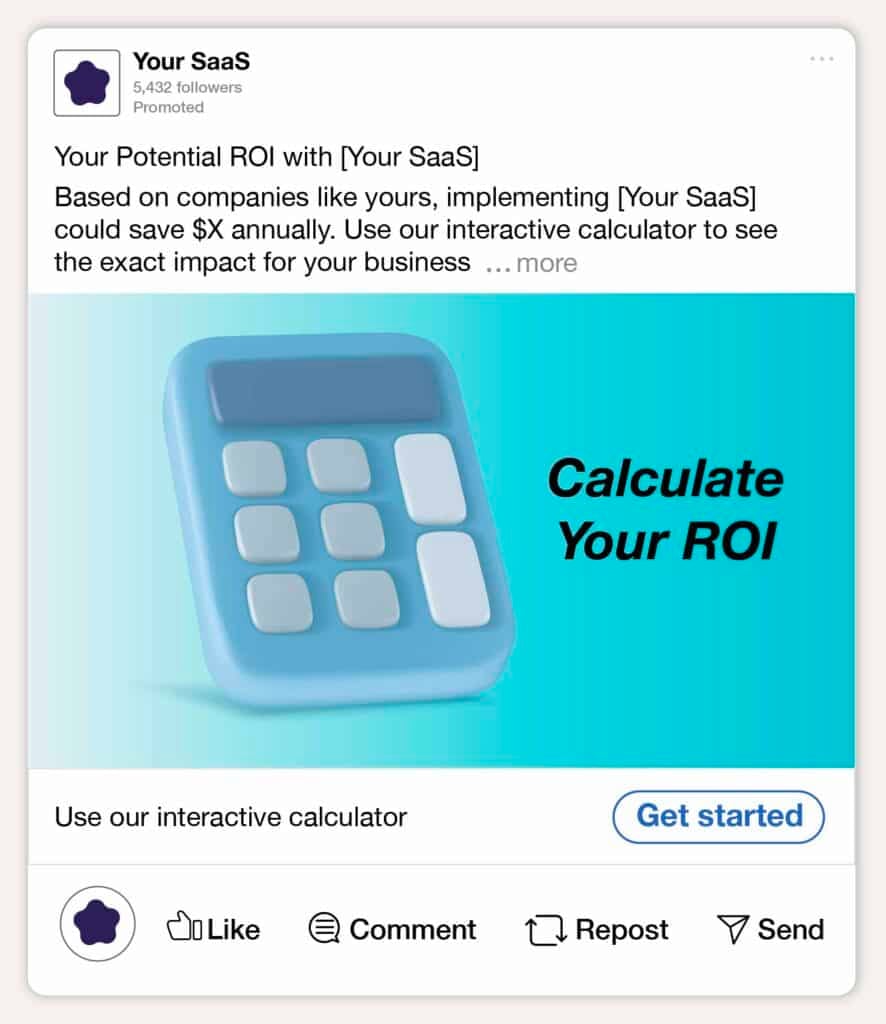
By sequencing channels and content this way, you warm up the account from multiple angles. Each stakeholder receives relevant information at the right time, and by the time the final proposal is discussed, the key people have already seen the proof they care about most.
In your specific SaaS case the sequence, messaging, and creative assets might be different.
At Camel Digital, we help you construct highly personalized campaigns that target the right people with the right message at the right time.
4. Align Sales and Marketing Teams
Sales and marketing should never operate as separate islands. When they work in isolation, marketing can bring in leads that sales sees as irrelevant, and sales can ignore valuable prospects simply because they were not involved in the targeting process. This not only wastes budget but also slows down deals and creates a disjointed customer experience.
On the opposite, when both teams work together, they target the right accounts, approach them with consistent messaging, and pass prospects along the pipeline without losing momentum.
The general idea is to connect sales and marketing so that every lead brought in, and even those selected to be targeted, is confirmed as qualified by both sides.
- Marketing confirms that the account fits the ideal customer profile and engagement criteria.
- Sales confirms that it has genuine potential to move forward.
From there, they move the account through the pipeline together, joining efforts where needed and stepping back when the other team takes the lead.
With B2B SaaS ABM, this alignment becomes part of the process. It starts with both teams agreeing on the ideal customer profile and defining a Service Level Agreement (SLA), which is a documented commitment on what qualifies as a marketing-qualified account, how quickly sales will follow up, and how handoffs will be handled.
A handoff is when one team formally transfers responsibility for the account to the next stage owner. For example, after a Sales Development Representative (SDR) runs initial demos and follow-ups, they introduce the Account Executive (AE) both via email and in the next call, giving full context so the AE can continue without gaps.
The same principle applies when the AE passes the customer to a Customer Success Manager after the deal closes. Smooth handoffs reduce friction, avoid confusion, and maintain trust.
There are different ways to organize this alignment, for example:
- Scenario 1: Marketing identifies in-market accounts, runs role-specific ads, SDRs follow up within 24 hours, AEs close deals, and Customer Success handles onboarding.
- Scenario 2: Sales shares recurring objections and questions from calls, marketing updates ad messaging and landing pages accordingly, and new campaigns produce better-qualified leads that are easier to close.
5. Track Metrics that Matter
Don’t get lost in metrics that look good on a report but have little to do with actual business growth. Click-through rates, impressions, and social likes can show activity, but they do not necessarily prove that your ABM efforts are moving the right accounts closer to becoming customers.
In B2B SaaS, the goal is not to generate the most clicks. It is to create a meaningful pipeline and revenue from high-value accounts.
Tracking the right metrics starts with aligning measurement to business outcomes.
- Instead of counting form fills, measure the number of marketing-qualified accounts (MQAs) that progress to sales-qualified accounts (SQAs).
- Instead of focusing only on cost per click, monitor cost per opportunity and cost per closed-won deal.
- Look at opportunity-to-close conversion rates, average deal size, and sales cycle length. These show how well your campaigns are impacting real revenue.
You should also measure engagement at the account level, not just the individual level. This means tracking how many key stakeholders within a target account have interacted with your ads, attended webinars, or visited relevant product pages. The more decision-makers you engage, the higher the likelihood of advancing the deal.
Finally, close the loop by feeding performance data back to both marketing and sales. When both teams know which campaigns generate pipeline and which channels bring in the right accounts, budgets can be adjusted toward what truly works.
Key Metrics for B2B SaaS ABM
To measure the impact of your account-based marketing strategy, focus on metrics that show progress in engagement, deal movement, and revenue growth. Let’s get into the most important KPIs for B2B SaaS.
Account Engagement
Start tracking account engagement, not surface-level stats like clicks or opens. Measure meaningful actions from your target accounts across channels:
- Visits to role-specific content and feature pages
- Downloads of case studies, ROI calculators, or whitepapers
- Webinar attendance and time spent in sessions
- Ad clicks tied to your target accounts (not anonymous viewers)
- Multi-stakeholder activity within the same account
Use your CRM or marketing tools to link engagement back to accounts so you can see trends across the group, not just individuals.
Pipeline Velocity
Pipeline velocity shows how quickly deals progress through your sales process and how much revenue moves during that time.
Pipeline Velocity = (Opportunities × Win rate × Average deal size) ÷ Sales cycle length (days).
Tracking this helps you understand whether your SaaS ABM efforts are actually speeding up conversions.
Look at the time from first engagement to closed-won, monitor the average sales cycle duration, and measure how revenue value changes as opportunities advance. Faster pipeline velocity means more revenue in less time from the accounts you target.
Deal Size Uplift
Average Contract Value (ACV) measures how much annual revenue you generate per account and is a key indicator of ABM success. It reflects your ability to attract and convert high-value customers.
ACV = Total contract revenue ÷ Number of accounts.
In ABM, the goal is not just to close deals but to secure larger, multi-year contracts by engaging multiple stakeholders and aligning with broader business objectives.
If your ACV is not increasing, review whether ABM accounts sign larger contracts, whether personalization leads to upsells or cross-sells, and how your ACV compares to relevant industry benchmarks.
CAC vs. LTV
Customer Acquisition Cost (CAC) measures how much you spend to acquire a single customer, calculated as: Total sales and marketing costs ÷ Number of new customers.
Lifetime Value (LTV) estimates the total revenue a customer generates over the entire relationship, calculated as Average revenue per account × Average customer lifespan.
In SaaS ABM, the aim is to keep CAC efficient while maximizing LTV through higher retention, upsells, and cross-sells.
A healthy LTV:CAC ratio, often considered to be 3:1 or higher, shows that your acquisition efforts are paying off. If CAC is rising faster than LTV, review targeting, sales cycles, and onboarding effectiveness.
Tools to Monitor ABM Performance
When your buying committee and campaigns are in place, the next priority is choosing tools that give you visibility into account-level impact across the SaaS marketing funnel. You need tools that do more than show clicks. They must show progression, engagement, and revenue outcomes.
First, you need Account Identification and Intent Tools
These help you spot which accounts are showing buying signals so you can target only active, high-potential companies. Tools like 6sense and Demandbase provide this capability, enriching your target list with fit and intent data while integrating with your existing systems.
Next, use Account Engagement and Analytics Platforms
They give you insight into who on the buying committee is interacting with your content, when they engage, and how often. PathFactory tracks how target accounts consume your content, measures engagement time, and identifies which topics resonate most. This allows you to see real movement through the funnel and adjust messaging based on actual behavior.
Then, find solid Campaign Management and Personalization Tools
Tools like RollWorks, or Madison Logic help you deliver tailored messages at scale. They enable targeted ads, dynamic personalization, and account-level tracking across touchpoints.
Finally, get access to CRM and Data Platforms
Platforms like Salesforce or HubSpot serve as your system of record, tying engagement and campaign performance to actual opportunities and revenue. This is where ABM results connect directly to revenue metrics within the SaaS marketing funnel.
When these tools work together, they create clear visibility from awareness to closed-won, enabling real-time optimization, deeper insights, and measurable ROI from ABM.
ABM for SaaS Startups: Is It Worth It?
As a startup with a tight budget, you are thinking whether investing in ABM is the best option for you. While we understand that at this stage you look for marketing that costs less and takes less effort, “cheap and easy” routes often end up in more costs and headache.
General SaaS ads without narrow targeting have a risk of sending your ads to people who will never buy from you. You might get clicks, but not the right ones.
ABM for SaaS startups flips that. You decide exactly who you want to reach, and every ad, every email, every message is aimed at them. Yes, it takes more thought upfront. But instead of paying for random impressions, you are talking directly to the companies that could become your best customers. That’s how you cut waste without cutting your chances of winning deals.
At Camel Digital, we’ve managed over $5 million in SaaS PPC campaigns.
We know how to target the right people.
We know how to spend less and get more.
So, we can help you avoid wasted budget and win high-value accounts faster.

Why SaaS ABM Is the Smart Play in 2025
SaaS growth in 2025 isn’t just about getting noticed. It is about getting noticed by the right companies and building the kind of trust that makes deals move forward. The market is noisy, budgets are tighter, and decision-makers are harder to reach. ABM works in this environment because it shifts the focus from “more leads” to “better opportunities.”
Think of it as running fewer races but making sure each one is worth the effort. Instead of chasing a high volume of random prospects, ABM for SaaS channels your time, budget, and creative energy into accounts that can truly impact revenue. It is a mindset shift as much as it is a marketing strategy.
If you’re not sure if your team is ready, take a hard look at your current process.
- Are sales and marketing working from the same account list?
- Do you have clear criteria for what makes an account worth pursuing?
- Can you measure how specific accounts move from first contact to closed deal?
Answering these questions will tell you if you have the structure to make ABM for SaaS work. In 2025, the companies that do will spend less, win more, and grow faster. At Camel Digital, your trusted B2B SaaS Marketing agency, we can help with that.
